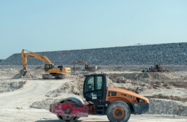Real estate prices in Qatar hit record highs in June after rising 28.9% year-on-year (y-o-y) according to the Real Estate Price Index (REPI) published by the Qatar Central Bank (QCB), its most recent data. The average prices for land, commercial and residential properties in June were 20% higher than the previous peak of September 2008, the central bank said.
The index showed that real estate prices were 18.5% higher in June than in January, based on Ministry of Justice data on land and property transactions.
It is not just prices that are rising, so is the number of transactions being conducted. According to a report from property developer the Ezdan Holding Group, y-o-y sales jumped by nearly a third in June, with land purchases making up an increasing proportion of transactions. Of the 627 deals struck in June, 446 were for plots of land, indicating increased activity from developers rather than sales of completed units or resale activity.
With prices and demand outstripping supply, there is some concern the real estate sector could impose unwanted pressures on the economy, according to a report by the Samba Financial Group. The report, issued at the end of July, said that while the y-o-y rate of price growth had moderated somewhat compared to 2013, rising demand would continue to push up prices in the short to medium term.
Supply & demand
Other economists suggest the large increases in real estate prices are in line with the fundamentals of Qatar’s fast growing economy and rapid population growth.
“While base (population) and income effect combined have increased by 345% since 2006, the QCB REPI has only risen by 326%, suggesting that real estate prices continue to be justified by Qatar’s economic fundamentals,” said QNB Economics in a note published at the end of August. “Further rapid increases in real estate prices could, however, signal overheating and a potential for another real estate bubble,” it added.
Demand is being fuelled by an influx of foreign workers engaged on infrastructure and development projects according to the Samba study, though this pressure on supply will likely ease towards the end of the decade as the pace of projects is scaled back.
The residential market will remain significantly undersupplied for at least the next five years, according to property consultancy, Colliers International. “Doha remains an upbeat market that is expanding in terms of overall offering while also bringing depth to the market,” said the firm in a report published in June, adding that Doha had a shortfall of almost 50,000 residential units. With a projected compound average growth rate of just 3% per annum, down from earlier estimates of 8%, Colliers said the supply/demand gulf would not be bridged quickly.
Qatar’s population increased at double-digit rates last year, and, as labour requirements gather pace across all sectors, this gap is set to widen substantially, fuelling price and rental costs.
The rise in population numbers is also forecast to feed into demand for retail and office space. However, in the case of the latter, demand will remain subdued due to high levels of space already available or scheduled to be completed over the course of this year and next.
Property development driving bank lending
The growth in real estate activity and subsequent rise in the building sector to meet this demand are driving bank lending levels. In July the QCB issued a report showing that loans to the real estate and contracting sectors accounted for just over 20% of all credit advanced by Qatar’s commercial banks. According to the bank, of total loans of $150bn, $30bn had been directed to the real estate and contractor market, of which $23.3bn was to the former.
This high level of lending to the sector leaves Qatar’s banks exposed should there be a sharp downturn, ratings agency Standard & Poor’s warned in May, saying setbacks to the property market – though unlikely – could pose a risk.
Surging demand for property could prompt developers to launch more projects through the end of 2014 and into 2015. Real estate prices and rental costs will continue to climb for the foreseeable future, though with the experience of the economic downturn of 2009 still fresh, regulators will likely move to contain any bubble, should it threaten to emerge.
Follow Oxford Business Group on Facebook, Google+ and Twitter for all the latest Economic News Updates. Or register to receive updates via email.

